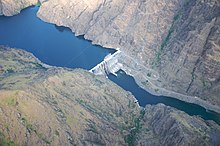Hells Canyon Dam
| Hells Canyon Dam | |
|---|---|
 Aerial view of the dam | |
| Location | Hells Canyon, Adams County, Idaho / Wallowa County, Oregon United States |
| Coordinates | 45°14′41″N 116°41′54″W / 45.24472°N 116.69833°W |
| Opening date | 1967 |
| Operator(s) | Idaho Power Company |
| Dam and spillways | |
| Impounds | Snake River |
| Height | 100 m (330 ft) |
| Reservoir | |
| Creates | Hells Canyon Reservoir |
| Total capacity | 232,000,000 m3 (188,000 acre⋅ft) |
| Catchment area | 189,800 km2 (73,300 sq mi) |
| Surface area | 10 km2 (3.9 sq mi) |
| Power Station | |
| Installed capacity | 391 MW |
| Annual generation | 2,051.3 GWh |
 | |
Hells Canyon Dam is a concrete gravity dam on the Snake River (river mile 247) in Hells Canyon on the Idaho-Oregon border. The dam impounds the Snake River in Hells Canyon Reservoir; its spillway elevation is 512 m (1,680 ft) above sea level.
It is the third and final hydroelectric dam of the Hells Canyon Project, which includes Brownlee Dam (1959) and Oxbow Dam (1961), all built and operated by Idaho Power Company. The Hells Canyon Complex on the Snake River is the largest privately owned hydroelectric power complex in the nation, according to the US Energy Information Administration.[1] The contractor for the Hells Canyon Dam was Morrison-Knudsen.
The Hells Canyon Dam powerhouse contains three generating units, with a total nameplate capacity of 391 megawatts (MW).[2] Power generation began with two units in 1967, the third came on line the following year.
Lacking passage for migrating salmon, the three dams of the Hells Canyon Project blocked access by anadromous salmonids to a stretch of the Snake River drainage basin from Hells Canyon Dam up to Shoshone Falls, which naturally prevents any upstream fish passage to the upper Snake River basin.
High dam proposal
As built, Hells Canyon Dam is significantly lower than it was originally proposed in the 1940s, with three dams (Hells Canyon, Brownlee Dam and Oxbow Dam) taking the place of a single 710-foot (220 m) high dam.[3] As proposed by the U.S. Army Corps of Engineers, the Hells Canyon High Dam would have been a straight-profile concrete gravity dam with two gate-controlled tunnel spillways, one in each abutment. The proposed reservoir was planned to have a capacity of 4,050,000 acre-feet (5.00 km3) with an area of 23,500 acres (9,500 ha). The reservoir was to extend 89 miles (143 km) upstream. The power plant was to be capable of generating 850 MW using ten units. The project included provisions for fish hatcheries, with the intention of maintaining salmon runs. Project cost was estimated at $342,076,000.[4] The high dam project was not pursued.

See also
References
- ^ "State Energy Profiles: Idaho". U.S. Department of Energy. December 23, 2010. Retrieved December 27, 2010.
- ^ "Hells Canyon Dam – General Information". Columbia Basin Research, University of Washington. Retrieved December 27, 2010.
- ^ "Hells Canyon". Idaho Power. Archived from the original on 18 July 2011. Retrieved 6 June 2011.
- ^
"Hells Canyon Dam : Hearings before the subcommittee on Irrigation and Reclamation of the Committee on Interior and Insular Affairs". Washington G.P.O. 1952. House of Representatives, 82nd Congress, 2nd session, on H.R. 5743,. Retrieved April 6, 2018.
Bill to authorize the construction, operation an maintenance of the initial phase of the Snake River reclamation project by the Secretary of the Interior.
{{cite web}}: CS1 maint: extra punctuation (link)
External links
- Hells Canyon Dam, Northwest Power and Conservation Council
- Hells Canyon Complex, Idaho Power
- Buildings and structures in Adams County, Idaho
- Dams in Idaho
- Dams in Oregon
- Hydroelectric power plants in Idaho
- Buildings and structures in Wallowa County, Oregon
- Idaho Power dams
- Dams completed in 1967
- Energy infrastructure completed in 1967
- Energy infrastructure completed in 1968
- 1967 establishments in Oregon
- Dams on the Snake River
- Gravity dams
- 1967 establishments in Idaho
